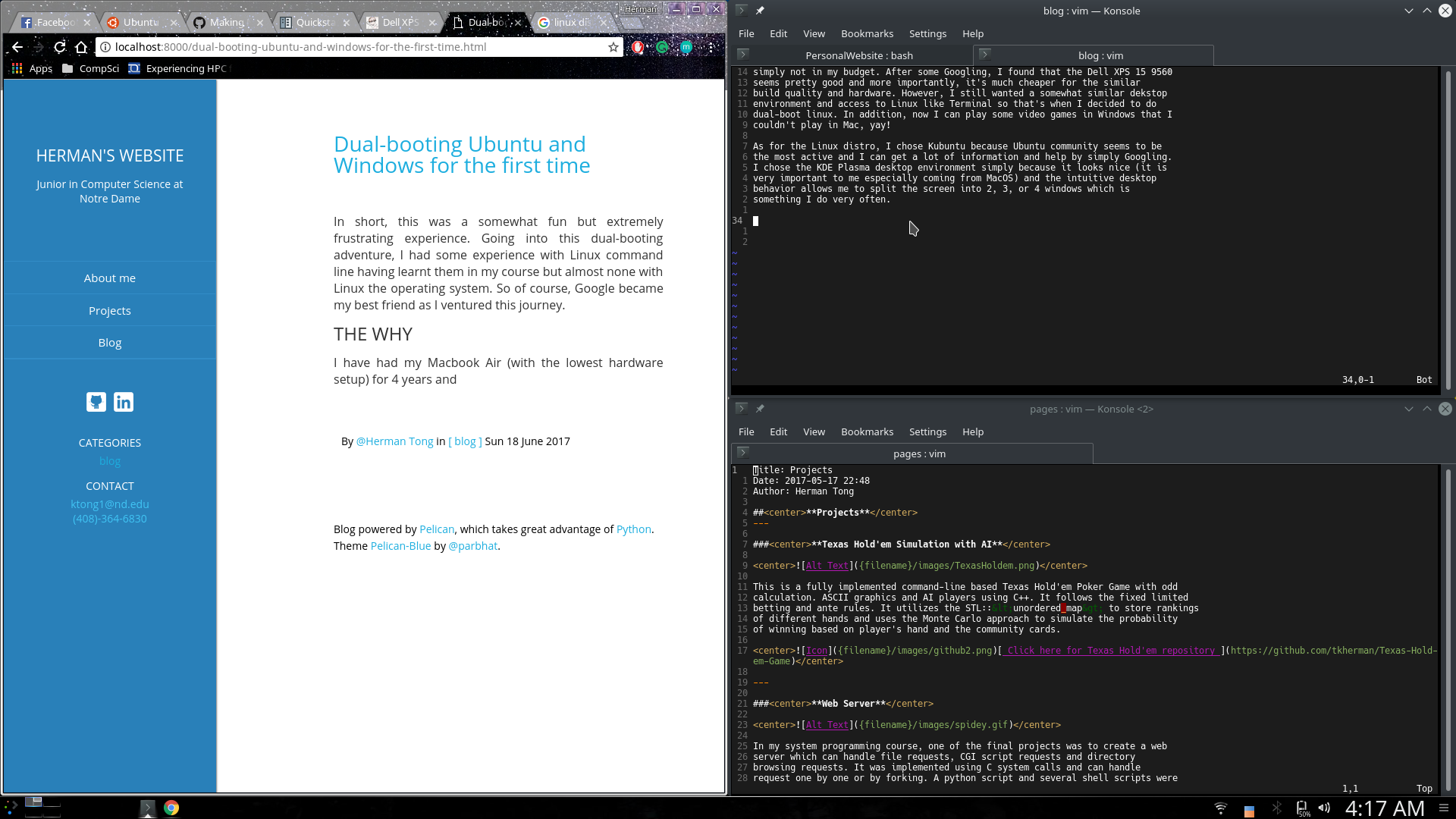In short, this was a somewhat fun but extremely frustrating experience. Going into this dual-booting adventure, I had some experience with Linux command line having learnt them in my course but almost none with Linux the operating system. So of course, Google became my best friend as I ventured this journey.
THE WHY
I have had my Macbook Air (with the lowest hardware setup) for 4 years and when it started to lag when "a few" tabs are opened on Chrome along with Spotify, Calendar and Terminal, I knew that it was a time to upgrade because it was somewhat affecting my productivity.
I have always liked the MacOS because I can easily do school work or side projects on the Terminal and desktop environment is plain and simple which is what I like. But looking at the price tag on the new 2017 MacBook Pro, it was simply not in my budget. After some Googling, I found that the Dell XPS 15 9560 seems pretty good and more importantly, it's much cheaper for the similar build quality and hardware. However, I still wanted a somewhat similar dekstop environment and access to Linux like Terminal so that's when I decided to do dual-boot linux. In addition, now I can play some video games in Windows that I couldn't play in Mac, yay!
As for the Linux distro, I chose Kubuntu because Ubuntu community seems to be the most active and I can get a lot of information and help by simply Googling. I chose the KDE Plasma desktop environment simply because it looks nice (it is very important to me especially coming from MacOS) and the intuitive desktop behavior allows me to split the screen into 2, 3, or 4 windows by dragging the windows to 4 corner which is something I do very often.

In short, I did:
- Boot in Windows and create a recovery disk on an USB using Windows built in software
- Use Rufus to create a bootable USB drive with the Kubuntu iso on it
- Partition my SSD
- 100GB for the Ubuntu OS
- ~130GB left for Windows
- Disable fast boot option in Windows
- Boot Windows in Safe Mode
- Enter BIOS to turn off Secure Boot and changed SATA Operation from RAID to AHCI then reboot
- Disable Safe Mode and then reboot again
- Insert the USB drive with Kubuntu 17.04 while holding F12 and run the
installation with the following partition
- 2GB for swap
- 20GB for /
- 75GB for /home
- read online that this make upgrading or changing desktop etc easier since the home partition is separted and won't be affected when upgrading
- this actually came in clutch when I reinstalled like 5 times after I mess something up later
This worked great, everything was working wifi, touchpad, sleep, shutdown and boot. Grub was working and I could switch between Ubuntu and Windows easily by rebooting. I then spent sometime customizing the Desktop because KDE offers so much customization and it's really great. I also installed tlp which is a battery manager. Installing and using it was simple (I didn't change any of the setting):
sudo add-apt-repository ppa:linrunner/tlp
sudo apt-get update
sudo apt-get install tlp
sudo tlp start
This worked pretty well as it imporved the battery life from 4-5 to around 9-10 hours. How this works, no idea but it works! lol
It was all good until one day, I felt my labtop burning through the backpack to the point where it was almost too hot to touch. It absolutely freaked me out thinking that I've already broke my new labtop.
What I think happened was that the computer didn't fully go into suspend with many processes still running in the background. However, the fan is turnt off so heat just kept building up until it was too hot. After hours and hours of Googling and messing around witht the system, including a few times of reinstalling the system, I think I've finally fixed it.
By default, Nouveau graphic driver is used when Ubuntu is installed. I think after some update, there was some bug with problem with the driver with the kernel. (Don't really know what or if I'm right or wrong) To fix that, I installed the Nvidia driver, updated the kernel. I followed this guide https://gist.github.com/whizzzkid/37c0d365f1c7aa555885d102ec61c048 by whizzkid and everything works perfectly now, well at least for now.
Essentially, when I'm using Kubuntu for daily usage, I use the integrated Intel GPU because it's much less power intensive than using the Nvidia GPU. The switching could be done by using prime-select (nvidia/intel) command. Since I only game on Windows, I can keep the integrated Intel GPU by default.